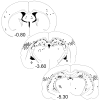Identification and characterization of heterogeneous neuronal injury and death in regions of diffuse brain injury: evidence for multiple independent injury phenotypes
- PMID: 15071102
- PMCID: PMC6729734
- DOI: 10.1523/JNEUROSCI.5048-03.2004
Identification and characterization of heterogeneous neuronal injury and death in regions of diffuse brain injury: evidence for multiple independent injury phenotypes
Abstract
Diffuse brain injury (DBI) is a consequence of traumatic brain injury evoked via rapid acceleration-deceleration of the cranium, giving rise to subtle pathological changes appreciated best at the microscopic level. DBI is believed to be comprised by diffuse axonal injury and other forms of diffuse vascular change. The potential, however, that the same forces can also directly injure neuronal somata in vivo has not been considered. Recently, while investigating DBI-mediated perisomatic axonal injury, we identified scattered, rapid neuronal somatic necrosis occurring within the same domains. Moving on the premise that these cells sustained direct somatic injury as a result of DBI, we initiated the current study, in which rats were intracerebroventricularly infused with various high-molecular weight tracers (HMWTs) to identify injury-induced neuronal somatic plasmalemmal disruption. These studies revealed that DBI caused immediate, scattered neuronal somatic plasmalemmal injury to all of the extracellular HMWTs used. Through this approach, a spectrum of neuronal change was observed, ranging from rapid necrosis of the tracer-laden neurons to little or no pathological change at the light and electron microscopic level. Parallel double and triple studies using markers of neuronal degeneration, stress, and axonal injury identified additional injured neuronal phenotypes arising in close proximity to, but independent of, neurons demonstrating plasmalemmal disruption. These findings reveal that direct neuronal somatic injury is a component of DBI, and diffuse trauma elicits a heretofore-unrecognized multifaceted neuronal pathological change within the CNS, generating heterogeneous injury and reactive alteration within both axons and neuronal somata in the same domains.
Figures











Similar articles
-
Mechanoporation induced by diffuse traumatic brain injury: an irreversible or reversible response to injury?J Neurosci. 2006 Mar 22;26(12):3130-40. doi: 10.1523/JNEUROSCI.5119-05.2006. J Neurosci. 2006. PMID: 16554464 Free PMC article.
-
Traumatic axonal injury in the perisomatic domain triggers ultrarapid secondary axotomy and Wallerian degeneration.Exp Neurol. 2006 Apr;198(2):350-60. doi: 10.1016/j.expneurol.2005.12.017. Epub 2006 Jan 31. Exp Neurol. 2006. PMID: 16448652
-
Traumatically induced axotomy adjacent to the soma does not result in acute neuronal death.J Neurosci. 2002 Feb 1;22(3):791-802. doi: 10.1523/JNEUROSCI.22-03-00791.2002. J Neurosci. 2002. PMID: 11826109 Free PMC article.
-
Cellular and subcellular change evoked by diffuse traumatic brain injury: a complex web of change extending far beyond focal damage.Prog Brain Res. 2007;161:43-59. doi: 10.1016/S0079-6123(06)61004-2. Prog Brain Res. 2007. PMID: 17618969 Review.
-
Cellular and molecular mechanisms of injury and spontaneous recovery.Handb Clin Neurol. 2015;127:67-87. doi: 10.1016/B978-0-444-52892-6.00005-2. Handb Clin Neurol. 2015. PMID: 25702210 Review.
Cited by
-
Increased intracranial pressure after diffuse traumatic brain injury exacerbates neuronal somatic membrane poration but not axonal injury: evidence for primary intracranial pressure-induced neuronal perturbation.J Cereb Blood Flow Metab. 2012 Oct;32(10):1919-32. doi: 10.1038/jcbfm.2012.95. Epub 2012 Jul 11. J Cereb Blood Flow Metab. 2012. PMID: 22781336 Free PMC article.
-
Impact of Neuronal Membrane Damage on the Local Field Potential in a Large-Scale Simulation of Cerebral Cortex.Front Neurol. 2017 Jun 7;8:236. doi: 10.3389/fneur.2017.00236. eCollection 2017. Front Neurol. 2017. PMID: 28638364 Free PMC article.
-
Arrested development and disrupted callosal microstructure following pediatric traumatic brain injury: relation to neurobehavioral outcomes.Neuroimage. 2008 Oct 1;42(4):1305-15. doi: 10.1016/j.neuroimage.2008.06.031. Epub 2008 Jul 4. Neuroimage. 2008. PMID: 18655838 Free PMC article.
-
The Effects of Cathepsin B Inhibition in the Face of Diffuse Traumatic Brain Injury and Secondary Intracranial Pressure Elevation.Biomedicines. 2024 Jul 19;12(7):1612. doi: 10.3390/biomedicines12071612. Biomedicines. 2024. PMID: 39062185 Free PMC article.
-
Cathepsin B Relocalization in Late Membrane Disrupted Neurons Following Diffuse Brain Injury in Rats.ASN Neuro. 2022 Jan-Dec;14:17590914221099112. doi: 10.1177/17590914221099112. ASN Neuro. 2022. PMID: 35503242 Free PMC article.
References
-
- Abravaya K, Myers MP, Murphy SP, Morimoto RI (1992) The human HSP hsp70 interacts with HSF, the transcription factor that regulates heat shock gene expression. Genes Dev 6: 1153–1164. - PubMed
-
- Adams JH (1992) Head injury. In: Greenfield's neuropathology (Adams JH, Duchen LW, eds), pp 106–152. New York: Oxford UP.
-
- Adams JH, Mitchell DE, Graham DI, Doyle D (1977) Diffuse brain damage of immediate impact type: its relationship to “primary brain-stem damage” in head injury. Brain 100: 489–502. - PubMed
-
- Barros LF, Castro J, Bittner CX (2002) Ion movements in cell death: from protection to execution. Biol Res 35: 209–214. - PubMed
-
- Blumbergs PC, Scott G, Manavis J, Wainwright H, Simpson DA, McLean AJ (1994) Staining of amyloid precursor protein to study axonal damage in mild head injury. Lancet 344: 1055–1056. - PubMed
Publication types
MeSH terms
Substances
Grants and funding
LinkOut - more resources
Full Text Sources
